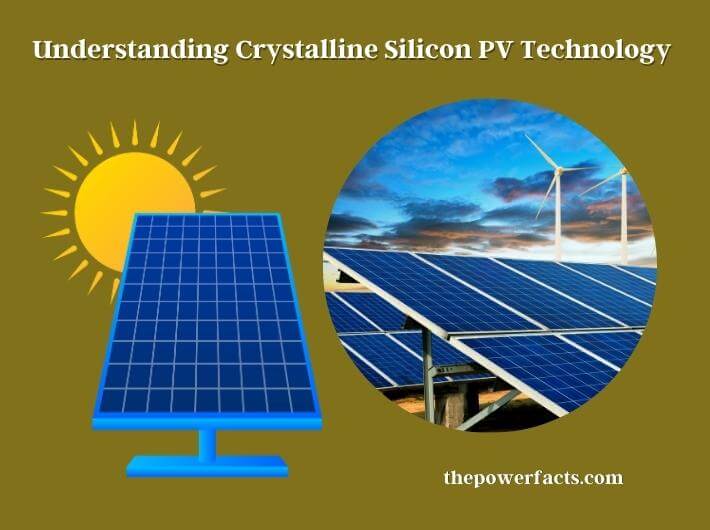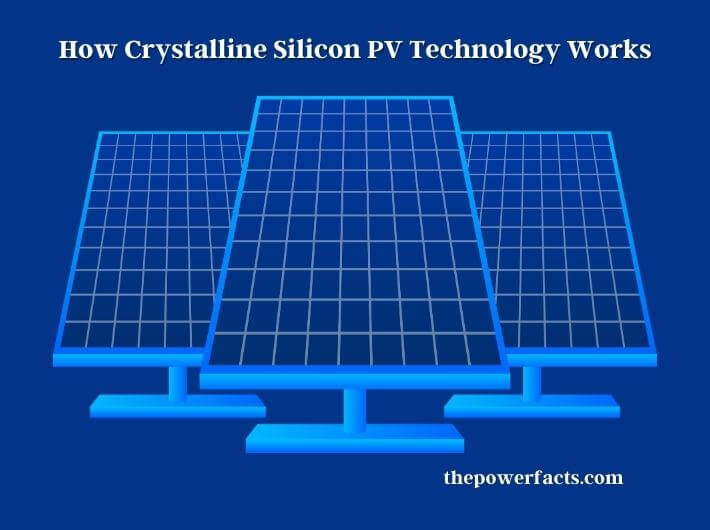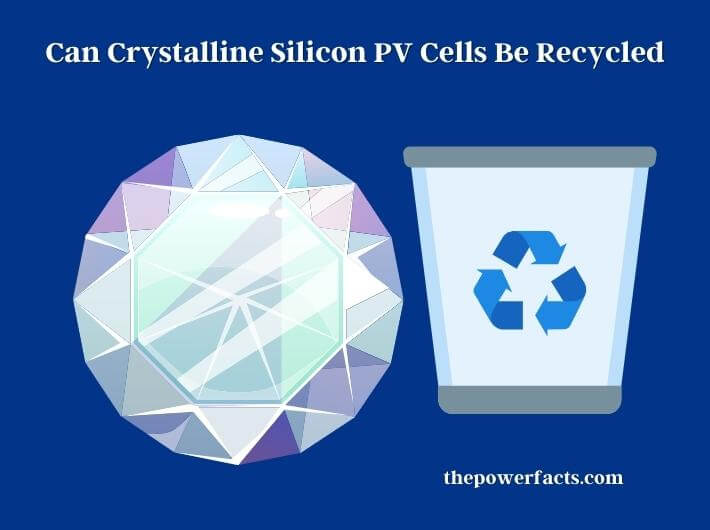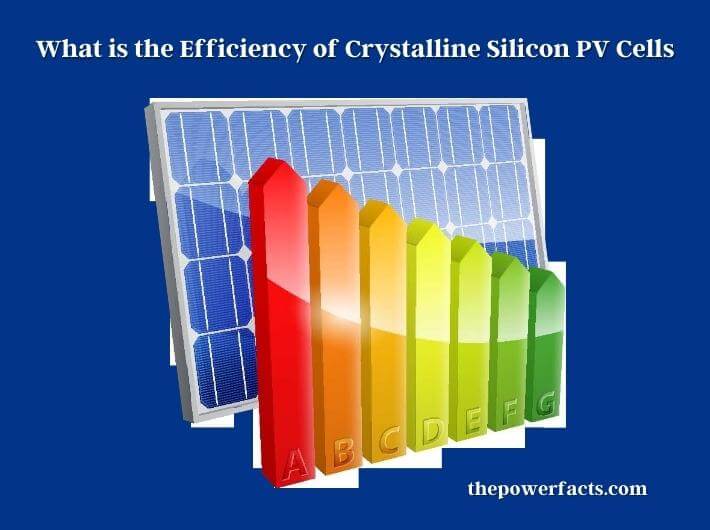As the world becomes increasingly aware of the need for sustainable and renewable energy sources, photovoltaic technology has emerged as a promising solution. Photovoltaic technology, also known as solar power, harnesses the sun’s energy to generate electricity through the use of photovoltaic cells.

Understanding photovoltaic technology, and in particular, crystalline silicon PV technology is crucial for those seeking to adopt renewable energy solutions. Crystalline silicon is the most widely used material in the production of photovoltaic cells due to its efficiency and durability.
Overview of Photovoltaic Technology
Photovoltaic technology, also known as solar power, is a renewable energy technology that generates electricity from the sun’s energy. The photovoltaic cells used in this technology are made of semiconducting materials such as silicon, and they convert sunlight directly into electricity.
The photovoltaic cells are assembled into panels, which can be used for various applications such as powering homes, businesses, and even entire communities. When sunlight strikes the photovoltaic cells, it generates an electric current that can be used to power appliances, lighting, and other electrical devices.
The advantages of photovoltaic technology are numerous. It is a clean and renewable source of energy, meaning it produces no harmful emissions or pollution. It is also a cost-effective solution for energy production, as the costs of solar panel installation and maintenance have decreased significantly in recent years. Photovoltaic technology has a low environmental impact compared to traditional fossil fuels and can help reduce reliance on non-renewable sources of energy.
There are also some challenges associated with photovoltaic technology. One of the main challenges is its dependence on sunlight, which means it may not be suitable for certain areas or during certain seasons. The initial cost of installing a solar panel system can be high, although this cost is usually offset by long-term savings on energy bills.
The potential benefits of photovoltaic technology make it an attractive option for those seeking to transition to renewable energy sources. you will focus specifically on crystalline silicon PV technology, one of the most widely used and efficient types of photovoltaic technology available today.
Crystalline Silicon PV Technology
Crystalline silicon PV technology is the most commonly used type of photovoltaic technology and is known for its high efficiency and durability. The basic principle behind crystalline silicon PV technology is the conversion of sunlight into electrical energy using semiconductor materials.
There are two types of crystalline silicon PV cells: monocrystalline and polycrystalline. Monocrystalline cells are made from a single crystal of silicon, while polycrystalline cells are made from many smaller crystals. Monocrystalline cells are generally more efficient but also more expensive to produce, while polycrystalline cells are less expensive but have a lower efficiency rate.
The manufacturing process of crystalline silicon PV cells involves several steps. First, raw silicon is purified and transformed into wafers. These wafers are then treated with dopants, which are elements that add or remove electrons from the silicon. This creates a p-n junction, which is the area where electrons are separated from the holes in the semiconductor material, generating an electrical current.
One advantage of crystalline silicon PV technology is its efficiency in converting sunlight into electricity. Monocrystalline cells can have an efficiency rate of up to 24%, while polycrystalline cells typically have an efficiency rate of 15-20%. Additionally, crystalline silicon PV cells have a longer lifespan and are more durable than other types of PV cells, with a typical lifespan of 25-30 years.
There are also some disadvantages associated with crystalline silicon PV technology. The manufacturing process requires a significant amount of energy and resources, and the panels themselves can be heavy and difficult to install. The efficiency of the cells can decrease in high temperatures, which can impact their performance in hotter climates.
Crystalline silicon PV technology is a highly efficient and durable option for those looking to generate renewable energy.
How Crystalline Silicon PV Technology Works?
Crystalline silicon PV technology works by converting sunlight into electrical energy through the use of semiconductor materials. When sunlight hits the surface of the photovoltaic cell, it excites the electrons in the semiconductor material, causing them to flow through the material and generate an electrical current.

The basic structure of a crystalline silicon PV cell consists of a layer of n-type (negative) silicon on one side and a layer of p-type (positive) silicon on the other side. The p-type silicon layer contains boron, which has one less electron than silicon and creates a positive charge, while the n-type silicon layer contains phosphorus, which has one more electron than silicon and creates a negative charge.
When sunlight hits the surface of the cell, it creates an electric field at the p-n junction where the two types of silicon meet. This electric field causes the electrons in the n-type layer to flow toward the p-type layer, while the holes in the p-type layer flow toward the n-type layer. This flow of electrons and holes generates an electrical current that can be used to power electrical devices.
The electrical current generated by a single photovoltaic cell is relatively small, so multiple cells are connected together to form a solar panel. The solar panels are then connected to an inverter, which converts the DC (direct current) electricity produced by the panels into AC (alternating current) electricity that can be used to power homes and businesses.
One advantage of crystalline silicon PV technology is that it can generate electricity even on cloudy days, although the efficiency of the cells will be lower than on sunny days. Additionally, the amount of electricity produced by the cells is proportional to the amount of sunlight they receive, so they are most efficient when they are pointed directly at the sun and receive maximum sunlight.
Benefits of Crystalline Silicon PV Technology
Crystalline silicon PV technology offers several benefits as a renewable energy source, making it an increasingly popular choice for homeowners and businesses alike.
Environmentally Friendly
One of the primary benefits of using crystalline silicon PV technology is that it is an environmentally friendly energy source. Unlike fossil fuels, which emit harmful greenhouse gases when burned, photovoltaic cells do not produce any emissions when generating electricity. This makes them a clean, sustainable source of energy that can help reduce our carbon footprint and mitigate the effects of climate change.
Cost-Effective
Another benefit of crystalline silicon PV technology is that it has become increasingly cost-effective in recent years. As technology has advanced and production has increased, the cost of PV cells and solar panels has decreased significantly. In many parts of the world, it is now cheaper to generate electricity using PV cells than it is using fossil fuels, making it a financially viable option for homeowners and businesses.
Low Maintenance
Crystalline silicon PV technology is also low maintenance compared to other types of renewable energy sources, such as wind turbines. Once the solar panels are installed, they require very little maintenance beyond occasional cleaning to remove dirt and debris. This makes them a convenient and hassle-free energy source for those looking to reduce their dependence on fossil fuels.
Long Lifespan
Another advantage of crystalline silicon PV technology is its long lifespan. PV cells can last for 25-30 years or more with proper maintenance, making them a durable and reliable energy source. This long lifespan also makes them a cost-effective investment for homeowners and businesses, as they can continue to generate electricity for many years after the initial installation.
Energy Independence
Using crystalline silicon PV technology can help promote energy independence, as it allows homeowners and businesses to generate their own electricity rather than relying on external sources. This can be especially important in remote areas or during power outages, where access to traditional sources of electricity may be limited.
Can Crystalline Silicon PV Cells Be Recycled?
Yes, crystalline silicon PV cells can be recycled. In fact, recycling programs have been established to recover valuable materials from discarded or damaged PV panels, including silicon wafers, aluminum frames, and glass.

The recycling process involves breaking down the PV panels into their individual components and then separating and purifying the materials for reuse. Recycling crystalline silicon PV cells can help reduce waste and conserve resources, making them an even more sustainable and environmentally friendly energy source.
What is the Future of Crystalline Silicon PV Technology?
Crystalline silicon PV technology has come a long way in recent years, and it continues to be a promising source of renewable energy for the future. Here are a few key developments to watch out for in the coming years:
Increased Efficiency
One area of ongoing research and development is improving the efficiency of crystalline silicon PV cells. While they are already highly efficient, with some cells reaching over 20% efficiency, there is still room for improvement. Researchers are exploring new materials and cell designs that could increase efficiency even further, potentially making PV cells an even more cost-effective and viable energy source.
New Applications
As the technology continues to improve, new applications for crystalline silicon PV cells are emerging. For example, researchers are exploring the use of PV cells in building materials, such as roof tiles and windows, which could allow buildings to generate their own electricity more efficiently. Other potential applications include integrating PV cells into clothing or other wearable devices to power electronics on the go.
Energy Storage
Another area of innovation is energy storage. While PV cells generate electricity during the day, they do not generate power at night or during cloudy weather. Energy storage solutions, such as batteries or hydrogen fuel cells, can help overcome this challenge by storing excess energy generated during the day for use later. As energy storage technology improves and becomes more affordable, it could further increase the viability and reliability of crystalline silicon PV technology.
Increased Adoption
The future of crystalline silicon PV technology will likely be shaped by increased adoption around the world. As more homeowners, businesses, and governments invest in solar energy, demand for PV cells and solar panels will continue to grow. This could lead to further cost reductions, increased innovation, and greater accessibility to clean, sustainable energy for everyone.
What is the Efficiency of Crystalline Silicon PV Cells?
The efficiency of a PV cell refers to the percentage of sunlight that is converted into usable electricity. Crystalline silicon PV cells are known for their high efficiency, which is one reason why they are a popular choice for solar energy systems. Here are a few key points to keep in mind:

- The efficiency of crystalline silicon PV cells can vary depending on the specific cell design, materials, and manufacturing processes used.
- In general, monocrystalline silicon cells tend to be more efficient than polycrystalline cells. Monocrystalline cells can reach efficiencies of up to 22%, while polycrystalline cells typically range from 15-17% efficiency.
- Efficiency can also be impacted by external factors such as temperature and shading. PV cells operate more efficiently at lower temperatures and when exposed to direct sunlight without shading.
- While efficiency is an important consideration, it is not the only factor that determines the performance and cost-effectiveness of a solar energy system. Other factors, such as durability, reliability, and cost, also play important roles.
While the efficiency of crystalline silicon PV cells can vary, they are known for their high performance and reliability, making them a popular choice for solar energy applications.
Conclusion
Crystalline silicon PV technology has been a key player in the growth of solar energy production over the last few decades. With their high efficiency, durability, and reliability, crystalline silicon PV cells have become a popular choice for residential, commercial, and utility-scale solar installations.
As the technology continues to evolve, advancements in manufacturing processes and materials are expected to further improve the efficiency and reduce the costs of crystalline silicon PV cells.
The increasing demand for renewable energy sources and the push for more sustainable practices are likely to drive the adoption of crystalline silicon PV technology in the years to come. The future of crystalline silicon PV technology looks bright, and it will continue to be an important part of the transition to a more sustainable and cleaner energy future.